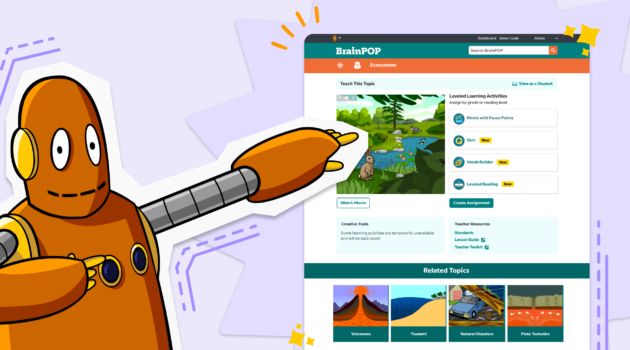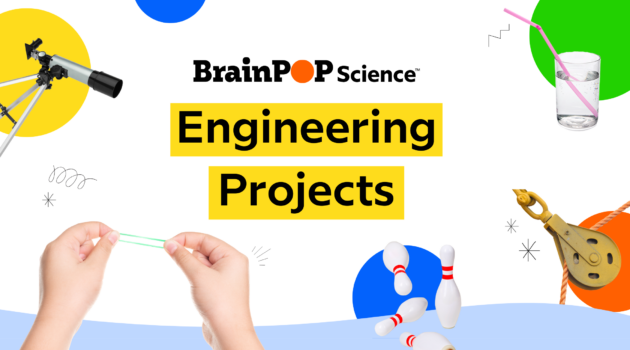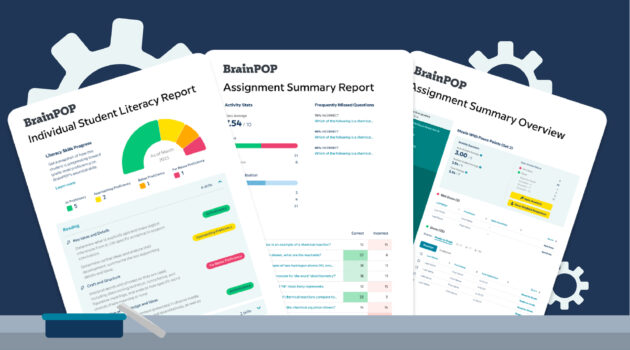New to BrainPOP
BrainPOP Product Release Notes: December 2021

Welcome to BrainPOP product release notes! Discover what’s new from BrainPOP Science, a new solution for middle school, and BrainPOP ELL, a leveled English language learning solution.
The Latest from BrainPOP Science
BrainPOP Science invites middle school students to confidently explore and explain the science behind real-world phenomena. This new instructional and assessment solution features meaningful (and fun!) opportunities for middle schoolers to practice real science, while seamlessly providing teachers and administrators with actionable data to guide students toward mastery.
Standards-aligned units consisting of investigations, interactive tools, and embedded assessments, invite students to dig into topics spanning life science, physical science, and earth and space science. Throughout each guided investigation, students gather evidence, manipulate real data, and explain their solutions—building essential, transferable scientific thinking skills and practices along the way!
Following the August launch, we have added even more robust product features over the last few months:
1. Eleven New Inquiry-Driven Investigations
- Multicellular Organisms: Construct an argument on how cells, tissues, and organs of the circulatory system interact with respiratory and digestive systems.
- Rock Strata and Earth’s History: Learn how scientists determine the relative dates of events by interpreting rock strata and fossils.
- Geologic Time Scale: Uncover how the geologic time scale is similar and different from the scale of human lifetime.
- Cell Membrane and Cell Wall: Analyze structures of the cell membrane and cell wall to determine how each relates to its function in the cell.
- Evidence of Common Ancestry: Construct an explanation on the evolutionary relationship between living and extinct organisms.
- Process of Cellular Respiration: Analyze models to understand how cell organelles undergo chemical reactions with oxygen to release stored energy.
- Renewable and Nonrenewable Resources: Identify explanations for the uneven distribution of natural resources across the US.
- Conservation of Energy: Understand how a machine can move without electricity.
- Gene Traits: Investigate what causes biological siblings to look different from one another.
- Sexual and Asexual Reproduction: Compare the genetic diversity of organisms including bees and plants.
- Human Impacts on the Environment: Apply scientific principles to explain causes of plastic pollution and effects that it has on natural habitats in Earth’s oceans.
Keep an eye out for six additional investigations due to launch by the end of 2021!
2. Growing Suite of Interactive Tools
BrainPOP Science features a collection of data manipulatives, simulations, and BrainPOP 3D WorldsⓇ, providing students authentic opportunities to practice real science.
We partnered with Field Day—the learning games studio and research lab at the Wisconsin Center for Education Research—to launch our first exclusive simulations: Cells, and Plant Growth. In these simulations, students explore cells in action, and experiment with conditions necessary for plants to grow and reproduce.
Say hello to our latest 3D Worlds:
- Moby on the Moon! Students observe the Sun, Earth, and Moon from different perspectives, and investigate how these celestial bodies in motion produce different phenomena in the sky.
- The Great Plastic Cleanup Project. Students observe engineers as they test two prototypes for cleaning plastic from the ocean, and investigate which features and materials are most effective—while keeping ocean wildlife safe.
3. In-Product State Science Standards
Upon logging in to BrainPOP Science, educators in Texas and Florida will see customized alignments to their state standards. This dynamic standards feature enables teachers to easily integrate BrainPOP Science content and assessments into their daily planning and long-term assessment preparation.
4. Unit Assessment Reports
School- and district-level administrators can now access data to glean actionable insights about student learning, performance, and assessment readiness. Plus, data can help inform professional development and resource decisions that support student, teacher, and curriculum needs.
The assessment report data includes performance band, progress toward proficiency, and measurement of mastery toward state science standards.
5. Microsoft Immersive Reader integration
In an effort to serve readers at all levels, BrainPOP Science now includes Microsoft Immersive Reader in our phenomena, simulations, data manipulatives, and BrainPOP 3D Worlds across all investigations. This integration will help to improve reading and accessibility for all students, and address challenges teachers face in supporting a wide range of reading abilities.
The Latest from BrainPOP ELL
BrainPOP ELL supports English language learners with 90 scaffolded lessons focusing on vocabulary, grammar, and conversational language skills.
1. Student Homepage Redesign
The newly updated student-facing homepage provides more support to help kids stay on task from the moment they log in. Students begin (or continue) a placement test, then view their assigned level—all from the homepage.
We love to hear from educators. How can we best meet your needs and the needs of your students? Please share your feedback with us!
Eugene Song is VP, product management at BrainPOP.






